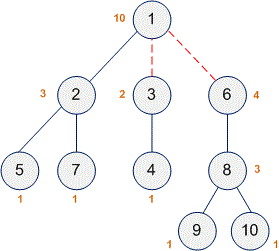Розбір
The task is to decompose the tree into connected components with an even number of vertices, while maximizing the number of such components.
We'll perform a depth-first search starting from vertex , which is the root of the tree. For each vertex , we'll determine the number of vertices in the subtree rooted at . If this number is even, we'll remove the edge connecting to its parent in the depth-first search.
For the root (vertex ), the size of the entire tree is even. However, there is no edge connecting vertex to its parent, so we must subtract from the result obtained using the above algorithm.
Example
Consider the tree shown in the example. Next to each vertex is the size of the subtree when that vertex is considered as the root. Vertices , and have subtrees with an even number of vertices. Since vertex is the root and does not have an edge leading to a parent, we remove two edges: and .

The tree has been decomposed into connected components, each containing an even number of vertices.
Algorithm realization
Declare the arrays.
#define MAX 101 int g[MAX][MAX], used[MAX];
The dfs function performs a depth-first search starting from vertex and returns the number of vertices in the subtree rooted at .
int dfs(int v)
{
used[v] = 1;In the variable , compute the number of vertices in the subtree rooted at .
int s = 1;
Iterate over the children of vertex . Add the values of to .
for (int i = 1; i <= n; i++)
if (g[v][i] && !used[i]) s += dfs(i);If the size of the subtree is even, remove the edge between and its parent.
if (s % 2 == 0) res++;
Return the number of vertices in the subtree rooted at .
return s; }
The main part of the program. Read the input data and build the graph.
scanf("%d %d", &n, &m);
for (i = 0; i < m; i++)
{
scanf("%d %d", &a, &b);
g[a][b] = g[b][a] = 1;
}Start a depth-first search from vertex . In the variable , count the number of removed edges.
res = 0; dfs(1);
Since there is no edge from to its parent, print .
printf("%d\n", res - 1);Python realization
The dfs function performs a depth-first search starting from vertex and returns the number of vertices in the subtree rooted at .
def dfs(v): used[v] = 1
In the variable , compute the number of vertices in the subtree rooted at .
s = 1
Iterate over the children of vertex . Add the values of to .
for i in range(1, n + 1):
if g[v][i] and not used[i]:
s += dfs(i)If the size of the subtree is even, remove the edge between and its parent.
if s % 2 == 0:
global res
res += 1Return the number of vertices in the subtree rooted at .
return s
The main part of the program. Read the input data and build the graph.
n, m = map(int, input().split()) g = [[0] * (n + 1) for _ in range(n + 1)] used = [0] * (n + 1) for _ in range(m): a, b = map(int, input().split()) g[a][b] = g[b][a] = 1
Start a depth-first search from vertex . In the variable , count the number of removed edges.
res = 0 dfs(1)
Since there is no edge from to its parent, print .
print(res - 1)